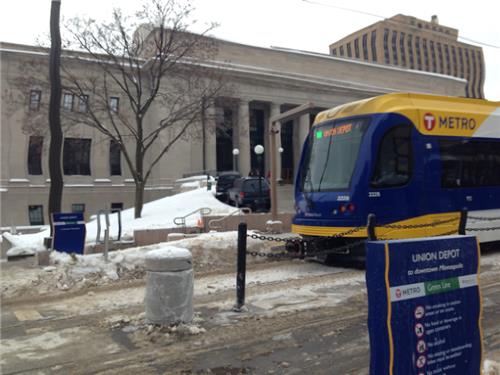
MPR reporter Laura Yuen’s fine story on the the new Green Line light rail service is quite a bucket of cold water for those of us who’ve been fairly anxiously awaiting the inauguration of service one month from today.
The initial estimate of a 40-minute trip on the rail line between downtown Saint Paul and downtown Minneapolis was already far too long — it’s a 26-minute bus trip now — and now, Yuen reports, test trains have taken an hour or more.
That’s not going to cut it by a long shot.
To be fair to Metro Transit, this is a test period with new drivers getting used to the route, but it’s troubling nonetheless.
“I’ve heard the chatter. I don’t understand why people are so worked up about this point,” St. Paul city engineer John Maczko told her. “We just put the stuff [in] and are just turning it on.”
“People are riding it are saying, ‘Hey, it’s taking too long.’ It’s kind of like letting you in the house before it’s even finished,” he said. “We’d prefer not to let you in until it’s finished, but everyone wants to see it. Then people get into the new house and say, ‘We don’t like this, we don’t like that.’ Well, we told you it wasn’t done yet.”
A better answer is, “we promise we’ll get you there in 35 minutes or less or the ride is free,” but mass transit isn’t a sub shop. We’ll take what we get at this point and we’ll find out in a month whether it’s worth riding.
But Mark Fuhrmann, who overseas the project for Metro Transit, seemed to be preparing us to accept the non-rapid nature of what we once called rapid transit.
Speed, Furhmann says, is not the first priority for the Green Line. The Met Council is keeping the express bus service for commuters who want to catch a ride between the downtowns, which typically takes about a half-hour.
It cost $1 billion to go 11 miles. And on the Green Line’s website, it emphasizes “service,” noting “trains will operate every 10 minutes during peak travel periods, with a travel time of 39 minutes between downtown St. Paul and downtown Minneapolis.
But Fuhrmann says most people won’t take the train from end to end.
“It’s not so important what the overall travel time is from end to end,” he said. “What’s really important is that these new Green Line passengers have a very high quality and reliable ride.”
To a non-expert who’s ridden public transportation in other cities, this seems a mistake.
One value of a built-out, interconnected rail system is that time does matter end to end because it’s a connection. Theoretically, one should be able to leave St. Paul, hop on light rail, transfer in Minneapolis and take the Blue Line to the airport in a reasonable period of time.
If the point of the Green Line, however, is primarily to serve a short hop from one station to another, St. Paul already had that system — the bus.
The light-rail line has to be a net positive at the same time. But rents have risen 24 percent on the Green Line corridor in anticipation of the service.
That’s good, we guess. It shows economic development (Update: A news release from the Met Council today claims over $2 billion in nearby construction is the result of light rail). But it also puts housing out of the reach of more people. It’s quite a balancing act for a light-rail line, especially once speed of service is removed from the “plus” side of the equation.
In some ways, the biggest challenge the Green Line planners faced was trying to keep everyone happy. In the face of public concern — mostly on University Avenue — more light-rail stations were built.
The line ended up with 18 stations over 11 miles. You can’t get a head of speed up when you’re stopping so frequently. True, there are 19 stations on the blue line’s 12 miles, but it’s only a 39-minute trip from downtown Minneapolis to the Mall of America.
What can be done to zip things up a bit? Yuen reports planners are installing a system to allow the light rail train to communicate with traffic signals to hold a green light until the light-rail passes. Hopefully it goes further and actually gives priority to the trains, at least on University.
If the train’s coming, change the light. The drivers can wait. If nothing else, it’d send a message to the drivers that the train is faster.
It might make sense to run express or semi-express service during rush hour and ignore some stations in the recognition of the fact that some people are interested in getting from one downtown to another. But that’s unlikely because there’s only a single track.
One option for accomplishing that: The bus.
Or a car.
